3. POSSIBLE TECHNOLOGIES [production]_ water cycle: draft report
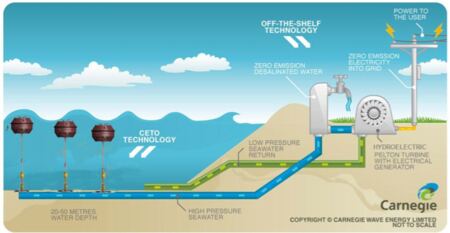
Part 3: Design of the future sustainable socio-technical sub-system in more detail
Produce water
3. Design of the future sustainable socio-technical sub-system in more detail
Within the last decades, water consumption has significantly increased. More specifically, every year the water demands are rising around 50billin m^3 [8]. As a result, different ways of water recycle are in a highlight.
3.3 Produce drinking water
3.3.1 Desalination towards sustainable ways - turning seawater into drinking water
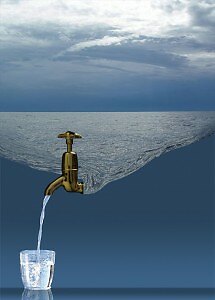
Global demand for water continues to increase due to population growth and economic development, whilst freshwater sources are becoming scarcer due to increasing demand for natural resources and the impacts of climate change. Desalination of seawater and brackish water can be used to augment the increasing demand for fresh water supplies. [1]
It is referred to the removal of salts and minerals in order to produce water suitable for human consumption or irrigation. Due to relatively high-energy consumption (often using energy supply from fossil fuel sources which are vulnerable to volatile global market prices as well as logistical supply problems in remote and island communities and are therefore not sustainable), the costs of desalinating seawater are generally higher than other alternatives (like river water, rain water or water recycle), but alternatives are not always available. [3]Moreover, the large amounts of energy have also an outsized impact on the environment. Simultaneously, desalination systems can damage the aquatic ecosystems by releasing large volumes of highly salty liquid brine back into the water. [2]
Engineers and entrepreneurs across the globe are now trying to devise greener and more sustainable ways for desalination. Some are inventing new alternatives. Technologies that shrink energy and brine or they are chemical-free or even energy-efficient enough to run on renewable energy sources [2].
Current information on desalination shows that only 1% of total desalinated water is based on energy from renewable sources. Renewables are becoming increasingly mainstream and technology prices continue to decline, thus making renewable energy a viable option. While desalination is still costly, declining renewable energy technology deployment costs are expected to bring this cost down in the coming years. This is of particular interest to remote regions and islands with small populations and poor infrastructure for freshwater and electricity transmission and distribution.
There are two broad categories of desalination technologies. Thermal desalination uses heat to vaporize fresh water, while membrane desalination (reverse osmosis) uses high pressure from electrically powered pumps to separate fresh water from seawater or brackish water using a membrane.
Thermal Desalination Technologies: Thermal desalination involves distillation processes where saline feed-water is heated to vaporize, causing fresh water to evaporate and leave behind a highly saline solution, namely the brine. Freshwater is then obtained from vapor cooling and condensation.
Membrane Desalination Technologies: Membrane desalination uses membranes to separate fresh water from saline feed-water. Feed-water is brought to the surface of a membrane, which selectively passes water and excludes salts.
Desalination based on Renewable Energy: Desalination based on the use of renewable energy sources can provide a sustainable way to produce fresh water. It is expected to become economically attractive as the costs of renewable technologies continue to decline and the prices of fossil fuels continue to increase. Using locally available renewable energy resources for desalination like rain, tides, waves, which are also related to our water cycle sub-system is likely to be a cost-effective solution particularly in remote regions, with low population density and poor infrastructure for fresh water and electricity transmission and distribution. As a result, the solution is to find a sustainable solution to produce renewable energy and afterwards to use it in order to desalinate seawater. The placement of a large scale desalination plant in the middle of the sea has distinct advantages over land based desalination - only at sea can we gather a plurality of renewable energy sources - like solar, wind, tide, current, OTEC [ocean thermal energy conversion].
The dominant energy source is solar photovoltaic (PV), which is used in some 43% of the existing applications, followed by solar thermal and wind energy. The right combination of a renewable energy source with a desalination technology can be the key to match both power and water demand economically, efficiently and in an environmentally friendly way. [1]
An example: Carnegie Wave Energy is planning to open the world’s first zero-emission wave powered desalination plant on Garden Island in Australia. Using the Perth Company’s proprietary “CETO technology,” the two-megawatt pilot project will operate with multiple submerged buoys tethered to pumps that funnel pressurized water to turbines onshore. There the water can either be harnessed to create electricity or to run and supply water for a reverse osmosis desalination plant. The CETO wave power converters are the first to be fully submerged under water, keeping them safe from the effects of major storms and reducing visual impact. The project on Garden Island in Western Australia will be a grid-connected, commercial scale operation that will demonstrate the technology’s viability, record its interactions with the environment, and help provide fresh water in an accordance with the West Australia Water Corporation. Desalination is an important part of Perth’s long-term strategy to maintain a supply of clean drinking water and the Carnegie Wave Energy technology will secure a means to provide this precious resource without relying upon energy-hungry machinery. Instead, by creating its own power, the CETO infrastructure can cut down on greenhouse gas emissions while also generating electrons and purified water. The project is expected to begin construction in 2014. [4]
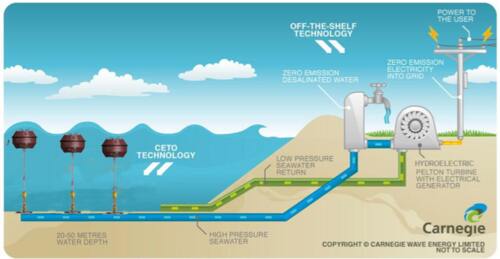
3.3.2 Produce drinking water from air humidity
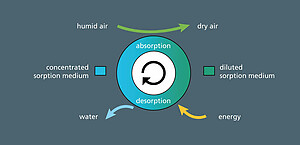
Even though there is a shortage of surface or groundwater, in often-considerable quantities, water is to be found in the air. Moreover, as a result of global warming it is to be expected that the water content of the atmosphere will increase further because of the rising temperatures. So that this water resource can be developed as a source of drinking water. The entire process consists of two parts. First, the humidity from the air is absorbed by a highly concentrated saline solution (brine) and thus bound. Then this diluted saline solution is distilled and the water separated from the saline solution is condensed as drinking water (desorption). [6]
Some example are the Skywater® machine and the atmospheric water generator (AWG), which we will explain below.
The Skywater® is a machine, which makes drinking water from humidity in the air. It is alleviate dependence from the local water supply, by harvesting enough fresh water from the air to supply a single-family home, office, and much more. The Skywater® 14home/office machine may be the most convenient kitchen appliance since the refrigerator. No more lifting heavy water bottles for your water cooler, simply plug in Skywater® products and enjoy fresh, great tasting water for pennies to the liter. [5]
The second example is the atmospheric water generator (AWG), which is a device that extracts water from humid ambient air. Water vapour in the air is condensed by cooling the air below its dew point, exposing the air to desiccants, or pressurizing the air. Unlike a dehumidifier, an AWG is designed to render the water potable. AWGs are useful where pure drinking water is difficult or impossible to obtain, because there is almost always a small amount of water in the air that can be extracted. The two primary techniques in use are cooling and desiccants. The extraction of atmospheric water may not be completely free of cost, because significant input of energy is required to drive some AWG processes, sometimes called "trading oil for water". Research has also developed AWG technologies to produce useful yields of water at a reduced (but non-zero) energy cost. [7]
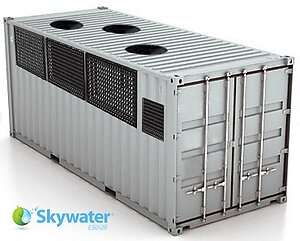
3.3.3 Rainwater Harvesting- got RAIN and get WATER
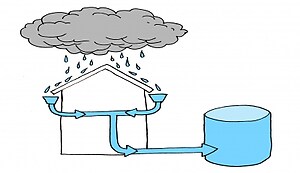
One direct, efficient, innovative, alternative and cheap solution, is the water harvesting.
The main steps of a rainwater harvesting system are to capture, storage, filter the rainwater and finally channel the clean one for use.
Rainwater harvesting is the accumulation and deposition of rainwater for reuse on-site, rather than allowing it to runoff. Uses include water for garden, water for livestock, water for irrigation, water for domestic use with proper treatment, indoors heating for houses etc. [9].
Can rainwater be made safe to drink? Yes. How safe? As safe as your well or tap water. How do you make it safe for indoor use? By filtering and purifying it. As a result, it can also use as potable water, as rainwater is substantially free of salinity and other salts.Bringing rain indoors could save the expense and environmental costs of treating and transporting water.
Rainwater harvesting is beneficial because provides an independent water supply during regional water restrictions by reducing the existing water supply and simultaneously providing water during the whole year, especially in drought seasons by reducing the run-off, the erosion and the contamination of surface water.
The main components of a rain harvesting system are a catchment surface, which can be also the roofs of the existing buildings or a new catchment surface, the conveyance system (pipes), the storage area, which ranges in sizes according the catchment surface and can be under or on the ground and the treatment system (filters, pump).
Contaminants in water may include algae, air pollution, bird excrement, and leaves, sand, and dust. Local wells have dealt with these problems for decades. Installation of filtration and purification equipment can remove these contaminants at home as well.
It is important to take measures and keep foreign matter out of the incoming rainwater. First flush devices, gutter screens and other screening mechanisms keep the rainwater as clean as possible before it enters the conveyance system. Using screens and filters will greatly reduce maintenance and lengthen the life of the pump and filtration/purification system. To keep sediment where it belongs, at the bottom of your tank, screen incoming rainwater, give the remaining sediment time to settle, avoid disturbing it, and don’t pull water from the bottom of the tank. Use a floating filter, which extracts water from the middle of the tank, leaving sediment undisturbed. Next is filtration, which removes debris from the water. Disinfection or purification follows, which kills contaminants and removes harmful substances that may be present. Filtration is included in every system, even simple irrigation systems. Examples of filtration systems include: screen filters, paper filters, and carbon or charcoal filters.
Almost all systems use multiple filters. For example, after gutter screens and/or a first flush device, a system often includes two in-line filters of increasing fineness, a carbon filter and a UV light. Each of these are described below to assist you in evaluating what might be the right alternative for your planned water use and required water quality. [10]
[1]http://www.irena.org/DocumentDownloads/Publications/IRENAETSAP%20Tech%20Brief%20I12%20Water-Desalination.pdf
[2]http://e360.yale.edu/feature/new_desalination_technologies_spur_growth_in_recyling_water/2770/
[3]http://en.wikipedia.org/wiki/Desalination
[4]http://inhabitat.com/carnegie-wave-energy-to-launch-the-worlds-first-wave-powered-desalination-plant/carnegie-power-water/
[6] http://www.islandsky.com
[7] http://en.wikipedia.org/wiki/Atmospheric_water_generator
[8]http://www.worldometers.info/water
[9]http://en.wikipedia.org/wiki/Rainwater_harvesting
[10]http://www.harvesth2o.com/filtration_purification.shtml#.VIR6p0s58ds


 Elia Galiouna
Elia Galiouna